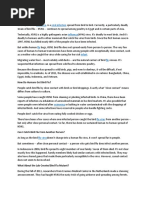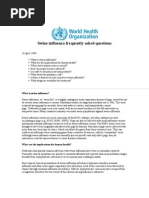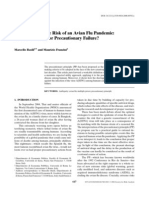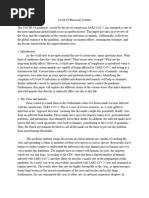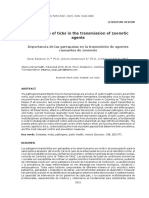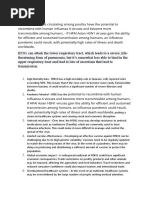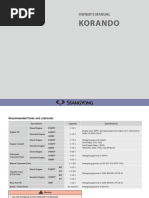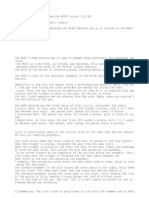What Is Avian Influenza?
What Is Avian Influenza?
Uploaded by
oendjoeCopyright:
Available Formats
What Is Avian Influenza?
What Is Avian Influenza?
Uploaded by
oendjoeOriginal Title
Copyright
Available Formats
Share this document
Did you find this document useful?
Is this content inappropriate?
Copyright:
Available Formats
What Is Avian Influenza?
What Is Avian Influenza?
Uploaded by
oendjoeCopyright:
Available Formats
What is avian influenza?
Avian influenza, or "bird flu", is a contagious disease of animals caused by viruses that normally infect only birds and, less commonly, pigs. While all bird species are thought to be susceptible to infection, domestic poultry flocks are especially vulnerable to infections that can rapidly reach epidemic proportions. The disease in birds has two forms. The first causes mild illness, sometimes expressed only as ruffled feathers or reduced egg production. Of greater concern is the second form, known as highly pathogenic avian influenza. This form, which was first recognized in Italy in 1878, is extremely contagious in birds and rapidly fatal, with a mortality approaching 100%. Birds can die on the same day that symptoms first appear. What are the control measures in birds? The most important control measures are rapid destruction (culling or stamping out) of all infected or exposed birds, proper disposal of carcasses, and the quarantining and rigorous disinfection of farms. The virus is killed by heat (56 degrees C for 3 hours or 60 degrees C for 30 minutes) and common disinfectants, such as fomalin and iodine compounds. The virus can survive, at cool temperatures, in contaminated manure for at least three months. In water, the virus can survive for up to four days at 22 degrees C and more than 30 days at 0 degrees C. For the highly pathogenic form, studies have shown that a single gram of contaminated manure can contain enough virus to infect 1 million birds. Restrictions on the movement of live poultry, both within and between countries, are another important control measure. What are the consequences of outbreaks in poultry? Outbreaks of avian influenza, especially the highly pathogenic form, can be devastating for the poultry industry and for farmers. For example, an outbreak of highly pathogenic avian influenza in the USA in 19831984, largely confined to the state of Pennsylvania, resulted in the destruction of more than 17 million birds at a cost of nearly US$ 65 million. Economic consequences can be especially devastating in developing countries where poultry raising is an important source of income and of food for impoverished rural farmers and their families.
When outbreaks become widespread within a country, control can be extremely difficult. For example, an outbreak that began in Mexico in 1992 was not completely controlled until 1995. For these reasons, government authorities usually undertake aggressive emergency control measures as soon as an outbreak is detected. How do outbreaks of avian influenza spread within a country? Within a country, the disease spreads easily from farm to farm. Large amounts of virus are secreted in bird droppings, contaminating dust and soil. Airborne virus can spread the disease from bird to bird, causing infection when the virus is inhaled. Contaminated equipment, vehicles, feed, cages or clothing especially shoes can carry the virus from farm to farm. The virus can also be carried on the feet and bodies of animals, such as rodents, which act as mechanical vectors for spreading the disease. Limited evidence suggests that flies can also act as mechanical vectors. Droppings from infected wild birds can introduce the virus into both commercial and backyard poultry flocks. The risk that infection will be transmitted from wild birds to domestic poultry is greatest where domestic birds roam freely, share a water supply with wild birds, or use a water supply that might become contaminated by droppings from infected wild-bird carriers. So called wet markets, where live birds are sold under crowded and sometimes unsanitary conditions, can be another source of spread. How does the disease spread from one country to another? The disease can spread from country to country through international trade in live poultry. Migratory birds, including wild waterfowl, sea birds, and shore birds, can carry the virus for long distances and have, in the past, been implicated in the international spread of highly pathogenic avian influenza. Migratory waterfowl most notably wild ducks are the natural reservoir of bird flu viruses, and these birds are also the most resistant to infection. They can carry the virus over great distances, and excrete it in their droppings, yet develop only mild and short-lived illness. Domestic ducks, however, are susceptible to lethal infections, as are turkeys, geese, and several other species raised on commercial or backyard farms.
What is the present situation? Since mid-December 2003, a growing number of Asian countries have reported outbreaks of highly pathogenic avian influenza in chickens and ducks. Infections in several species of wild birds and in pigs have also been reported. The rapid spread of highly pathogenic avian influenza, with outbreaks occurring at the same time in several countries, is historically unprecedented and of great concern for human health as well as for agriculture. Particularly alarming, in terms of risks for human health, is the detection of a highly pathogenic strain, known as H5N1, as the cause of most of these outbreaks. H5N1 has jumped the species barrier, causing severe disease in humans, on two occasions in the recent past and is now doing so again, in gradually growing numbers, in Viet Nam and Thailand. Why so much concern about the current outbreaks? Public health officials are alarmed by the unprecedented outbreaks in poultry for several reasons. First, most but not all of the major outbreaks recently reported in Asia have been caused by the highly pathogenic H5N1 strain. There is mounting evidence that this strain has a unique capacity to jump the species barrier and cause severe disease, with high mortality, in humans. A second and even greater concern is the possibility that the present situation could give rise to another influenza pandemic in humans. Scientists know that avian and human influenza viruses can exchange genes when a person is simultaneously infected with viruses from both species. This process of gene swapping inside the human body can give rise to a completely new subtype of the influenza virus to which few, if any, humans would have natural immunity. Moreover, existing vaccines, which are developed each year to match presently circulating strains and protect humans during seasonal epidemics, would not be effective against a completely new influenza virus. If the new virus contains sufficient human genes, transmission directly from one person to another (instead of from birds to humans only) can occur. When this happens, the conditions for the start of a new influenza pandemic will have been met. Most alarming would be a situation in which person-to-person transmission resulted in successive generations of severe disease with high mortality.
This was the situation during the great influenza pandemic of 19181919, when a completely new influenza virus subtype emerged and spread around the globe, in around 4 to 6 months. Several waves of infection occurred over 2 years, killing an estimated 4050 million persons. Is there evidence of efficient human-to-human transmission now? No. WHO teams in Viet Nam and Thailand are supporting governments in the design and conduct of studies needed to detect the earliest stage of human-tohuman transmission. In parallel activities, laboratories in the WHO Global Influenza Surveillance Network are urgently conducting studies on both human and avian viruses, obtained in the current outbreaks. These studies are also expected to shed some light on the origins and characteristics of the currently circulating H5N1 strain. Moreover, a new virus adapted for efficient human-to-human transmission would spread very rapidly, and health authorities would know very quickly that a completely new virus had emerged. There is no evidence, to date, that this has occurred. Does human infection with H5N1 happen often? No. Only very rarely. The first documented human infections with the H5N1 avian strain occurred in Hong Kong in 1997. In that first outbreak, 18 persons were hospitalized and 6 of them died. The source of infection in all cases was traced to contact with diseased birds on farms (1 case) and in live poultry markets (17 cases). The human cases coincided with outbreaks of highly pathogenic H5N1 avian influenza in poultry. Very limited human-to-human transmission of the H5N1 strain was documented in health care workers, family members, poultry workers, and workers involved in culling operations. Though H5 antibodies were detected in these groups, indicating infection with the virus, no cases of severe disease occurred as a result. Antibodies were detected in 10% of the poultry workers studied, and in 3% of the cullers. In February 2003, the H5N1 strain again jumped from birds to infect two members of a family (a father and his son) when they returned to Hong Kong following travel in southern China. The father died but the son recovered. A third member of the family, the boys sister, died of a severe respiratory illness in China. No samples were available for determining the cause of her death.
Are all of the currently reported outbreaks in birds equally dangerous for humans? No. Outbreaks caused by the H5N1 strain are presently of the greatest concern for human health. In assessing risks to human health, it is important to know exactly which avian virus strains are causing the outbreaks in birds. For example, the outbreak of avian influenza recently reported in Taiwan, China is caused by the H5N2 strain, which is not highly pathogenic in birds and has never been known to cause illness in humans. The outbreak recently announced in Pakistan is caused by H7 and H9 strains, and not by H5N1. However, urgent control of all outbreaks of avian influenza in birds even when caused by a strain of low pathogenicity is of utmost importance. Research has shown that certain avian influenza virus strains, initially of low pathogenicity, can rapidly mutate (within 6 to 9 months) into a highly pathogenic strain if allowed to circulate in poultry populations. Can a pandemic be averted? No one knows for sure. Influenza viruses are highly unstable and their behaviour defies prediction. However, WHO remains optimistic that, if the right actions are taken quickly, an influenza pandemic can be averted. This is WHOs foremost objective at present. The first priority, and the major line of defence, is to reduce opportunities for human exposure to the largest reservoir of the virus: infected poultry. This is achieved through the rapid detection of poultry outbreaks and the emergency introduction of control measures, including the destruction all infected or exposed poultry stock, and the proper disposal of carcasses. All available evidence points to an increased risk of transmission to humans when outbreaks of highly pathogenic avian H5N1 influenza are widespread in poultry. As the number of human infections grows, the risk increases that a new virus subtype could emerge, triggering an influenza pandemic. This link between widespread infection in poultry and increased risk of human infection is being demonstrated right now in Asia. All human cases and deaths detected so far are in two countries Viet Nam and Thailand with very widespread outbreaks in poultry.
WHO stresses the urgency of the situation and the need for rapid action in the animal and agricultural sectors. For example, the culling in 1997 of Hong Kongs entire bird population an estimated 1.5 million chickens and other birds was done in 3 days. Again in 2003, the culling of nearly 30 million birds (out of a total bird population of 100 million) in the Netherlands was done within a week. Rapid action in both of these situations is thought by many influenza experts to have averted an influenza pandemic in humans.
You might also like
- UMAT ExampleDocument9 pagesUMAT ExampleAnonymous WAgzcf9No ratings yet
- Y Yy Yy Y Y YYY Yyyy Yyyyy Y Y YDocument14 pagesY Yy Yy Y Y YYY Yyyy Yyyyy Y Y YAnis NadhirahNo ratings yet
- Avian Influenza Text Rev Edited (With Line Numbers)Document4 pagesAvian Influenza Text Rev Edited (With Line Numbers)duolingoaucNo ratings yet
- What Is Bird Flu?Document5 pagesWhat Is Bird Flu?rye08No ratings yet
- Bird FluDocument5 pagesBird FluNader SmadiNo ratings yet
- Chapter I, 2,3Document13 pagesChapter I, 2,3Purna SallyNo ratings yet
- Summary 1: Bird Flu: Avian InfluenzaDocument15 pagesSummary 1: Bird Flu: Avian InfluenzaedrichaNo ratings yet
- Avian Flu: The Next Pandemic of The 21st Century?: Presented By: Leslie BealeDocument26 pagesAvian Flu: The Next Pandemic of The 21st Century?: Presented By: Leslie BealeNayyar Raza KazmiNo ratings yet
- What Is Bird FluDocument20 pagesWhat Is Bird FluMuhsin TahirNo ratings yet
- Influenza Viral Infection: What Is Bird Flu?Document4 pagesInfluenza Viral Infection: What Is Bird Flu?Ashlene Kate BagsiyaoNo ratings yet
- Avian Influenza:: An Internal Report For The College of Food, Agricultural, and Environmental SciencesDocument36 pagesAvian Influenza:: An Internal Report For The College of Food, Agricultural, and Environmental SciencesBharath ReddyNo ratings yet
- JM Jurnal Flu Burung PDFDocument13 pagesJM Jurnal Flu Burung PDFjm narsisNo ratings yet
- Birdflu PPDocument57 pagesBirdflu PPdvo aizawlNo ratings yet
- 7 Deadliest Diseases in HistoryDocument9 pages7 Deadliest Diseases in HistoryRth CMglNo ratings yet
- Slide NarrativeDocument3 pagesSlide NarrativeAgentFelix BrianNo ratings yet
- How To Protect Your Health and Wealth From The Bird Flu PandemicDocument18 pagesHow To Protect Your Health and Wealth From The Bird Flu Pandemicrichard aaryNo ratings yet
- Avian Influenza (Bird Flu)Document4 pagesAvian Influenza (Bird Flu)Gia Mae MagdaleraNo ratings yet
- Bird Flu: Frequently Asked Questions: Why Doesn't Bird Flu Spread Easily From Human To Human?Document3 pagesBird Flu: Frequently Asked Questions: Why Doesn't Bird Flu Spread Easily From Human To Human?cianNo ratings yet
- 01 Urgent Information About Swine Flu PPT 2009/10Document4 pages01 Urgent Information About Swine Flu PPT 2009/10Oscar VilcaNo ratings yet
- Swine Flu Key FactsDocument3 pagesSwine Flu Key Factsctkennedy100% (1)
- Swine Influenza: Nature of The DiseaseDocument8 pagesSwine Influenza: Nature of The Diseasejawairia_mmgNo ratings yet
- NIH Public Access: Author ManuscriptDocument20 pagesNIH Public Access: Author ManuscriptteacherferhdzNo ratings yet
- Part B 33 Pandemic FluDocument6 pagesPart B 33 Pandemic FluLeah ValenciaNo ratings yet
- Epidemiology of Avian Influenza in GhanaDocument5 pagesEpidemiology of Avian Influenza in GhanaYvonne Sorviel SiiloNo ratings yet
- Orthomyxoviridae Family of Viruses. Influenza Virus A Includes Only One Species: Influenza A Virus WhichDocument5 pagesOrthomyxoviridae Family of Viruses. Influenza Virus A Includes Only One Species: Influenza A Virus Whichapi-33708392No ratings yet
- Vector and Zoonoses Control 2019. Health Care LectureDocument60 pagesVector and Zoonoses Control 2019. Health Care LectureGwyneth Marie Dayagan100% (1)
- Zoonoses From PoultryDocument7 pagesZoonoses From PoultryDulce AmorNo ratings yet
- Bird FluDocument16 pagesBird FluShubh NougrahiyaNo ratings yet
- World Health Organization - Swine Flu FAQ (April 26, 2009)Document3 pagesWorld Health Organization - Swine Flu FAQ (April 26, 2009)antcomtech100% (9)
- Avian Influenza (Bird Flu)Document8 pagesAvian Influenza (Bird Flu)Ezra TorehNo ratings yet
- Rol de Las Aves en Epidemiología en Transmisión de ZoonosisDocument21 pagesRol de Las Aves en Epidemiología en Transmisión de ZoonosissandraNo ratings yet
- Understanding The Risk of An Avian Flu Pandemic: Rational Waiting or Precautionary Failure?Document15 pagesUnderstanding The Risk of An Avian Flu Pandemic: Rational Waiting or Precautionary Failure?jen610iNo ratings yet
- Bird FluDocument15 pagesBird Fluzs0786.03014914395No ratings yet
- The Bird Flu and YouDocument15 pagesThe Bird Flu and YouMahogony ScottNo ratings yet
- CDC Vs WHODocument7 pagesCDC Vs WHOlistiarsasihNo ratings yet
- bird-flu-scare-narrative-ramps-up-pdfDocument10 pagesbird-flu-scare-narrative-ramps-up-pdflagarra50No ratings yet
- Way of Taking Heed and Preventing Spreading of Disease of Flu Bird (Avian Influenza)Document14 pagesWay of Taking Heed and Preventing Spreading of Disease of Flu Bird (Avian Influenza)piusndNo ratings yet
- Zoonotic Diseases 1Document2 pagesZoonotic Diseases 1MelNo ratings yet
- Wong Et Al. (2007)Document25 pagesWong Et Al. (2007)Sammer Cañesares BurgosNo ratings yet
- Is Factory Farming Making You Sick?Document15 pagesIs Factory Farming Making You Sick?Vegan FutureNo ratings yet
- EnvironmentDocument4 pagesEnvironmentCharlotte ZhouNo ratings yet
- H5N1Document17 pagesH5N1ياسرNo ratings yet
- Covid-19 Biosocial Systems - DemoDocument2 pagesCovid-19 Biosocial Systems - Demomahersandy08No ratings yet
- Symposium Transcript 11 2004Document49 pagesSymposium Transcript 11 2004Mark ReinhardtNo ratings yet
- Human Influenza A (H5N1) : A Brief Review and Recommendations For TravelersDocument6 pagesHuman Influenza A (H5N1) : A Brief Review and Recommendations For TravelersvijayNo ratings yet
- The Problem and Its ScopeDocument4 pagesThe Problem and Its ScopeCJ ManlangitNo ratings yet
- Emerging and Re-Emerging Infectious Diseases 20.11.2023Document57 pagesEmerging and Re-Emerging Infectious Diseases 20.11.2023johnnycash5404No ratings yet
- Pigeon Associated People Diseases: Digitalcommons@University of Nebraska - LincolnDocument4 pagesPigeon Associated People Diseases: Digitalcommons@University of Nebraska - LincolnBIOSPIN NOVI SADNo ratings yet
- Bird FluDocument21 pagesBird FluARG ShovonNo ratings yet
- Pandemic ContempDocument3 pagesPandemic ContempSeer FelaireNo ratings yet
- C CCCC CC CCCDocument18 pagesC CCCC CC CCCRichard QuiochoNo ratings yet
- tmp63B0 TMPDocument15 pagestmp63B0 TMPFrontiersNo ratings yet
- H5N1 Potential ThreatsDocument5 pagesH5N1 Potential ThreatsVincent OsorioNo ratings yet
- Health Doc 2Document1 pageHealth Doc 2atifNo ratings yet
- Swine InfluenzaDocument13 pagesSwine Influenzathewhiteknight1989No ratings yet
- The Great Bird Flu Hoax: The Truth They Don't Want You to Know About the 'Next Big Pandemic'From EverandThe Great Bird Flu Hoax: The Truth They Don't Want You to Know About the 'Next Big Pandemic'Rating: 3.5 out of 5 stars3.5/5 (8)
- Crofer 22 HDocument27 pagesCrofer 22 HSarveshNo ratings yet
- Focus SE 2013 2.0LDocument419 pagesFocus SE 2013 2.0LRoberto Carlos Cardenas QuirozNo ratings yet
- CTP ReviewrDocument11 pagesCTP ReviewrHel John100% (2)
- Course Outline OPMG4230 - 2024Document4 pagesCourse Outline OPMG4230 - 2024Kevin ValaniNo ratings yet
- K385WHI RCD Connection Unit Tech FINALDocument1 pageK385WHI RCD Connection Unit Tech FINALbrightstardustNo ratings yet
- SpirotechDocument2 pagesSpirotechBimalesh MishraNo ratings yet
- Burning Mouth Syndrome BARUDocument26 pagesBurning Mouth Syndrome BARUMariatun Zahro NasutionNo ratings yet
- Perhitungan RAS CileungsiDocument1 pagePerhitungan RAS CileungsiFannyaNo ratings yet
- 00-V005 Document Control Procedure Rev 180311Document21 pages00-V005 Document Control Procedure Rev 180311Tuong NguyenNo ratings yet
- Mastery Test Week 1Document2 pagesMastery Test Week 1Eljean HipolitoNo ratings yet
- Riso RZ200 BrochureDocument4 pagesRiso RZ200 BrochureCarlos VairinhosNo ratings yet
- Linke Hofmann Busch Coaches (LHB) : ADARSH (14113004) AJAY SINGHAL (14113007)Document15 pagesLinke Hofmann Busch Coaches (LHB) : ADARSH (14113004) AJAY SINGHAL (14113007)Deepak MahawarNo ratings yet
- Costa QtnaireDocument4 pagesCosta QtnaireDipesh JainNo ratings yet
- Sales Invoice SI 2021 22 784 289483Document1 pageSales Invoice SI 2021 22 784 289483NAVNEET CHOUDHURYNo ratings yet
- Diabetes 4 LifeDocument8 pagesDiabetes 4 LifeBhavin VoraNo ratings yet
- ENVS ProjectDocument24 pagesENVS ProjectSwarup Dey ChowdhuryNo ratings yet
- Drishti Interview 2016Document181 pagesDrishti Interview 2016rahimdad mukhtariNo ratings yet
- Korando C300 - LHDDocument510 pagesKorando C300 - LHDDani DanielNo ratings yet
- Mrs Tilschers Class - Duffy 1Document4 pagesMrs Tilschers Class - Duffy 1Shriya JagwayanNo ratings yet
- 3.automobile Engineering-IDocument14 pages3.automobile Engineering-IAmrithNo ratings yet
- 1991 - Antal Et Al - Analysis of Phase Distribution in Fully Developed Laminar Bubbly Two - Phase FlowDocument18 pages1991 - Antal Et Al - Analysis of Phase Distribution in Fully Developed Laminar Bubbly Two - Phase FlowLeiza D'AngeloNo ratings yet
- Bifacial Module Installation Manual - ENDocument11 pagesBifacial Module Installation Manual - ENGabrielDarienTeporaVillarNo ratings yet
- Polyurethane Coating Specification Steel PipeDocument11 pagesPolyurethane Coating Specification Steel PipeDaniel Barni HulbertNo ratings yet
- 240c ClassDocument3 pages240c ClassDan SloNo ratings yet
- Dames and Moore - 1981-Geologic Reconnaissance Survey Prima DeshechaDocument20 pagesDames and Moore - 1981-Geologic Reconnaissance Survey Prima DeshechaBrian McDanielNo ratings yet
- Researchu - AttitudeDocument48 pagesResearchu - AttitudeJabez CabahugNo ratings yet
- Cultural Hegemony: A Gramscian Perspective On Counterculture - Gaelle MazraanyDocument5 pagesCultural Hegemony: A Gramscian Perspective On Counterculture - Gaelle MazraanyGaelle Mazraani100% (1)
- 19721-Article Text-49632-1-10-20210219Document8 pages19721-Article Text-49632-1-10-20210219M RamdanNo ratings yet
- Ultra-Thin Whitetopping (UTW) Project: UTW Thickness (MM) Joint Spacing (M) Fiber Concrete Plain ConcreteDocument3 pagesUltra-Thin Whitetopping (UTW) Project: UTW Thickness (MM) Joint Spacing (M) Fiber Concrete Plain ConcreteEric GironNo ratings yet









